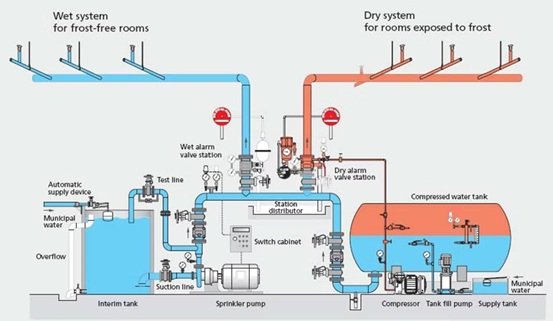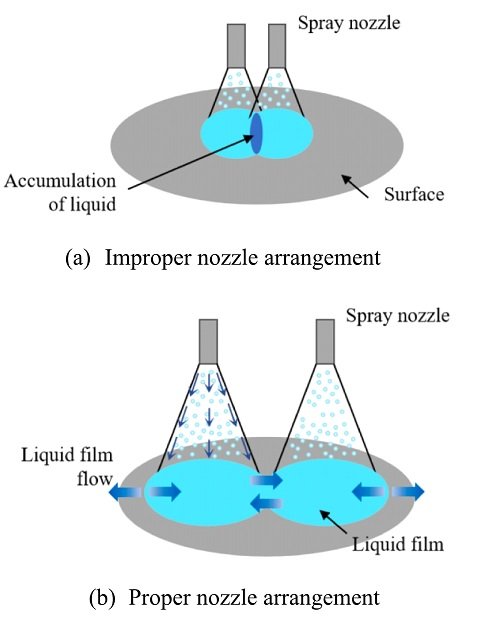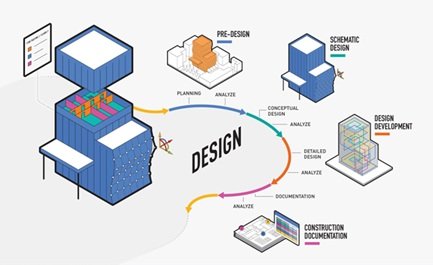With the rapid development of the construction industry, the scale, height and complexity of construction projects are also increasing. However, in the current era, with the wide application of computer technology, there are many new methods and means for construction project management. Building information modeling (BIM), as an integrated digital tool, has been widely used in the management of civil engineering projects. In the field of architecture in the new era, new breakthroughs have been achieved in the aspects of design, structure and technology. Based on this, this study first introduces the basic concepts and characteristics of BIM technology, and then reviews the existing problems of traditional civil engineering project management. On this basis, this study puts forward some specific measures and methods to improve the efficiency of civil engineering project management, including information sharing, collaborative design and conflict detection. This study provides a new way of thinking and method for civil engineering project management, and improves the quality, efficiency and sustainable development ability of the project.
Construction industry is an important pillar industry of our national economy, which directly affects the development of national economy. Although the construction industry maintains a rapid and stable development trend, there are problems such as production efficiency, data sharing degree, low information level and resource waste, which lead to the construction industry of our country is still in a relatively backward level [1, 2]. One of the important reasons is that the scale of engineering projects in China, the complexity of building forms and construction technology is increasing, and the amount of project data is increasing rapidly. The traditional project management mode can not obtain project data timely and effectively, and can not realize the fine and information management of the construction industry. With the development of computer technology, digital technology and Information technology, Building Information Modeling (BIM) has been introduced into the construction industry and has been widely used in all stages of engineering projects, in which comprehensive geometric information and engineering feature information of buildings are stored [3, 4]. This information can be quickly extracted for engineering project management, which brings an opportunity to improve the informatization level and efficiency of engineering project management and change the status quo of the construction industry.
In recent years, civil engineering project management is facing more and more challenges. The traditional civil engineering project management method has many problems in the process of information transmission, cooperation and decision-making, such as inaccurate information, poor communication, unscientific decision-making and so on [5, 6]. These problems lead to project schedule delay, cost overruns and quality problems, which seriously affect the efficiency of project management and the overall benefit of the project.
This paper aims to explore how to use BIM technology to improve the efficiency of civil engineering project management. As an innovative information management and collaboration tool, BIM technology has the characteristics of integration, visualization and collaboration, which can effectively solve the problems existing in traditional project management. By studying the application of BIM technology in civil engineering project management, it can provide project teams with more accurate, comprehensive and real-time information support, strengthen communication and collaboration between teams, improve the scientific and accuracy of decision-making, and thus improve the management efficiency and overall benefit of civil engineering projects [7, 8].
BIM (Building Information Modeling) is the three-dimensional modeling of various data in the process of construction projects, and the digital restoration of various component information in construction projects through digital means. BIM is not simply to complete the three-dimensional construction of construction projects, but to comprehensively manage the whole life cycle and various types of data of construction projects [9]. BIM technology realizes the comprehensive integration of various elements of construction projects, and at the same time gathers all kinds of participants in construction projects into the same platform for design, implementation and acceptance, revolutionizing the management process and management method of construction projects.
At present, BIM technology widely spread in China and the world mainly has five characteristics.
The visual environment is the basis of all operations of BIM technology. BIM gets rid of the traditional two-dimensional lines of building components, but presents them dynamically in front of project managers through three-dimensional forms. Using BIM technology, all data and information of various forms and types can be fully connected to the model, and can be displayed in a visual form, especially the visual dynamic simulation and presentation of abstract data, which can make decision-making more scientific and transparent and improve the efficiency of management decision-making.
The coordination of BIM technology is mainly reflected in the coordination of the design stage and the construction stage of the whole life cycle of the project. The coordination of the design stage is mainly reflected in the automatic correlation design between various professional designs, which can coordinate the coordination simulation and optimization of various professional designers to form the most scientific and accurate design drawings. The construction stage is mainly based on the BIM model for coordination and management among the participants to improve management efficiency and level.
This feature is mainly a demonstration of the advantages of BIM technology information storage, BIM model and platform can store all the data, information and information of the whole life cycle of the project, and can ensure that all information will not be lost, can be repeatedly consulted, and all saved in the database.
BIM database provides a platform and environment for the data sharing and use of all participants. All data and information in the project can be integrated into the platform through one-time manual input or automatic collection, which can realize the common access and use of data and information in the whole project construction process. Avoid inconsistent data input for multiple times.
Simulation means that the BIM model of the project can be simulated in advance through software, which cannot be carried out under traditional two-dimensional conditions, such as energy-saving simulation, emergency evacuation simulation, construction schedule simulation, construction organization design simulation, construction scheme simulation, etc.
In the construction process of civil engineering projects, the most obvious problem is the conflict between construction drawings and scheme requirements. Due to the characteristics of complex design, complex construction and short construction period of some projects, there is a large possibility of mistakes in the design process.
For example, taking the design process of air conditioning purification system as an example, in order to fully reduce the number of pipes in the ceiling area and further reserve space for subsequent equipment installation and maintenance, the owner requires that the secondary return air system be changed to the fresh air +FFU+ dry coil system, which results in hundreds of FFUs being added inside the ceiling. In addition, its installation position is in great conflict with the original fire sprinkler head, and the additional workload caused by the correction of the above conflict is 110 working hours in total, which exceeds 10% of the original design workload of the air conditioning purification system [10, 11]. The layout diagram of the fire sprinkler head for water supply and drainage is shown in Figure 1.

The readjusting arrangement of spray and FFU is shown in Figure 2.
In order to solve the installation conflicts caused by the above scheme changes, it is necessary for the owner to coordinate the construction units of the above two types of systems, and redesign the drawings based on the original design. The occurrence of the above problems often affects the entire project period, because the spray system has not been optimized in the design process [12, 13]. As a result, design drawings and construction requirements need to be changed in the later construction process, and the above situation occurs relatively frequently. In the construction process of individual systems, design drawings may be changed several times, and subsequent space replanning will bring no small challenge to BIM application.

With the rapid standardized development of China’s construction industry, obtaining construction projects through construction bidding has become an important way for construction enterprises to obtain construction tasks. For construction enterprises, the success rate of bidding and reasonable settlement profit rate are the key to ensure the survival and development of construction enterprises. In the process of bidding for construction projects, the competition among construction enterprises becomes more and more fierce. In order to reduce the risks in the bidding process and ensure their winning rate is getting higher and higher, construction enterprises usually attach great importance to the preparation of construction bidding documents in the bidding stage. However, there are still three main problems in the process of bidding management of construction enterprises, which lead to low efficiency of bidding work and lower the winning rate and profit rate of construction enterprises [14, 15].
The traditional preparation of technical standard documents of construction enterprises mostly relies on the past project construction experience, and the feasibility of construction plans lacks sufficient demonstration and simulation, which easily leads to changes in construction techniques and methods during the construction stage, resulting in construction costs and progress getting out of control. On the other hand, in the process of technical bid evaluation, paper technical bid documents are mostly reviewed [16, 17]. Although there are corresponding pictures to supplement the description, in a relatively short period of time, the lack of highlights in the form of expression can not fully demonstrate the technical advantages of construction enterprises, resulting in the technical bid can not obtain a high score, affecting the project’s winning rate.
The main tasks and work contents of construction enterprises in the construction preparation stage are to do various preparatory work, meet the necessary conditions of project construction, and ensure that the construction work can be carried out normally. The main work in the construction preparation stage includes establishing the construction site project management organization, getting familiar with and deepening the design drawings, joint examination of the construction drawings, preparing the construction organization design, the overall construction preparation work, signing various procurement and subcontract, applying for commencement and organizing mobilization [18]. According to the key process, the existing problems of construction enterprises in this work mainly include the following two points:
Construction organization planning is an important part of engineering project management. However, in the traditional preparation process, due to the difficulty of resource balance in preparation, the staggered construction procedures, the lack of experience of technical personnel, the low efficiency of preparation methods and other factors, the implementation of construction organization design is increasingly unable to play a guiding role. It is difficult for construction enterprises to guarantee the specific progress objectives, quality objectives and cost objectives of the engineering projects they undertake, which has seriously restricted the project management level of many domestic construction enterprises.
In the process of civil engineering design, BIM technology is fully utilized to ensure the construction effect, construction efficiency and construction cost of the project. Therefore, it is necessary to make full use of the advantages of BIM system, give full play to various derivative and expansion functions of the system, and reduce the human intervention operation of the project.
The BIM model should start from the overall building structure of the industrial plant and run through the design in the early stage, the construction in the middle stage and the acceptance and maintenance in the later stage. At the same time, the conversion of the original design drawings should be done well in the construction process of the project to ensure that the original design drawings are consistent with the converted BIM model.
In the subsequent BIM application optimization, the secondary integrated development of Revit should be carried out to fully establish BIM application technology integrating project design, engineering volume statistics, cost budget and schedule management, so as to further improve the application effect of BIM technology in this example. Meet the comprehensive requirements of the project engineering management department for project design and construction quality, time limit and cost accounting.
According to the diagnosed problems in calculation and valuation, engineering quantity review, technical plan selection and other aspects of the preparation process of the key process of the bidding stage, the application of BIM technology can solve the above problems in the bidding work and improve the quality and efficiency of the bidding work. For example, using the data characteristics of BIM model can improve the traditional calculation method, improve the speed and accuracy of bidding calculation, and save a lot of manpower and material resources; Through the construction scheme simulation of BIM technology, the selection of technical standard scheme can be optimized and the bidding ability can be improved. Through information technology, it can improve the linkage of technical and business objectives, and promote the coordination and unification of technical solutions and business quotations; Through visualization, the presentation and expressiveness of bidding documents can be improved. The process reengineering diagram of bid-document preparation based on BIM is shown in Figure 3.

The key process of project management of construction enterprises in the construction preparation stage mainly includes the deepening design process and the construction organization design process. According to the problems existing in the two key processes of construction enterprises at present, the problems are as follows: first, the deepening design lacks intuitiveness, low efficiency, little additional information, and the quality of design results is not high; Second, the construction organization design is difficult, low efficiency, the quality of documents is not high, and the guidance is not strong, which seriously affects the efficiency and quality of the construction enterprise project management. In view of these two aspects, the application direction of BIM technology at this stage is determined to be BIM collaborative deepening design and BIM construction organization design, and the BIM based deepening design and construction organization design process reengineering schematic diagram, as shown in Figure 4.

To sum up, BIM technology has become the leading technology of digitization of current engineering construction and has been widely used in all stages of construction projects. Through the effective application of BIM technology, it can help realize the effective control of engineering construction, operation management and the entire project quality and management efficiency, save costs and shorten the construction period. Therefore, in the face of the problems existing in the application of BIM technology at this stage, we should also pay attention to the advancement of BIM technology, integrate with various elements of engineering site management, improve the intelligent level of engineering management, and provide a strong basis and support for civil engineering construction management.
Sbiti, M., Beddiar, K., Beladjine, D., Perrault, R., & Mazari, B. (2021). Toward BIM and LPS data integration for lean site project management: A state-of-the-art review and recommendations. Buildings, 11(5), 196.
Liu, Y., & Zub, A. T. (2020, June). Research on the application of BIM technology in the efficiency and effectiveness of construction project management. In Journal of Physics: Conference Series (Vol. 1574, No. 1, p. 012081). IOP Publishing.
Mandičák, T., Mesároš, P., & Tkáč, M. (2020). Construction project management through BIM and knowledge technology. Pollack Periodica, 15(1), 177-186.
Lin, Y. C., Hsu, Y. T., & Hu, H. T. (2022). BIM model management for BIM‐based facility management in buildings. Advances in Civil Engineering, 2022(1), 1901201.
Chen, L., Yang, H. N., Xiao, Y., Tang, P. Y., Liu, S. Y., Chang, M., & Huang, H. (2024). Exploring spatial pattern optimization path of urban building carbon emission based on low-carbon cities analytical framework: A case study of Xi’an, China. Sustainable Cities and Society, 111, 105551.
Tian, Y., Wu, J., Xu, Z., & Guan, X. (2025). Integrated modeling and dynamic evaluation indicator system of urban energy systems towards a sustainable, low-carbon pathway. Energy, 134993.
Zhiwu, W., Tianfu, H., Chunguang, W., Xiang, W., & Yanzhao, T. (2025). Enhanced on-site testing of DC current transformers using improved EMD filtering and high-precision synchronization. Mari Papel y Corrugado 2025 8-15.
Zhang, Y. (2025). An innovative deep learning method for IoT malware identification. Mari Papel y Corrugado, 2025, 29-37.
Simon, M., & M. Din., Salwa (2025). Performance evaluation of self-organizing features in wireless sensor networks. TK Techforum Journal (ThyssenKrupp Techforum), 2025(1). 12-19.
Dr. Tallat, R., & Dr. Chandra, N. (2024). Synthesis and Fabrication of High-Performance p-Type Silicon Nanowire Transistors. TK Techforum Journal (ThyssenKrupp Techforum), 2024(2). 32-39.
Zhang, Z., Gao, Q., Shao, S., Zhang, Y., Bao, Y., & Zhao, L. (2024). Carbon emission scenarios of China’s construction industry using a system dynamics methodology–Based on life cycle thinking. Journal of Cleaner Production, 435, 140457.
Wu, J., & Ying, X. (2024). Development trend of green residential buildings in China under the guidance of the low-carbon concept: A policy review and analysis. Journal of Urban Management, 13(2), 246-261.
Li, H., Zeng, D., Chen, L., Chen, Q., Wang, M., & Zhang, C. (2016). Immune multipath reliable transmission with fault tolerance in wireless sensor networks. In Bio-inspired Computing–Theories and Applications: 11th International Conference, BIC-TA 2016, Xi’an, China, October 28-30, 2016, Revised Selected Papers, Part II 11 (pp. 513-517). Springer Singapore.
Du, M., Antunes, J., Wanke, P., & Chen, Z. (2022). Ecological efficiency assessment under the construction of low-carbon city: a perspective of green technology innovation. Journal of Environmental Planning and Management, 65(9), 1727-1752.
Zhang, Q., & Li, J. (2023). Building carbon peak scenario prediction in China using system dynamics model. Environmental Science and Pollution Research, 30(42), 96019-96039.
Pan, W., Yu, C., & Du, J. (2022). A dialectical system framework for green building assessment in high-density cities. Environmental Impact Assessment Review, 97, 106860.
Yao, H., Xu, P., Wang, Y., & Chen, R. (2023). Exploring the low-carbon transition pathway of China’s construction industry under carbon-neutral target: A socio-technical system transition theory perspective. Journal of Environmental Management, 327, 116879.
Parekh, R., & Trabucco, D. (2024). Recent progress in integrating BIM and LCA for sustainable construction: A Review. International Journal of Science and Research Archive, 13(1), 907-932.